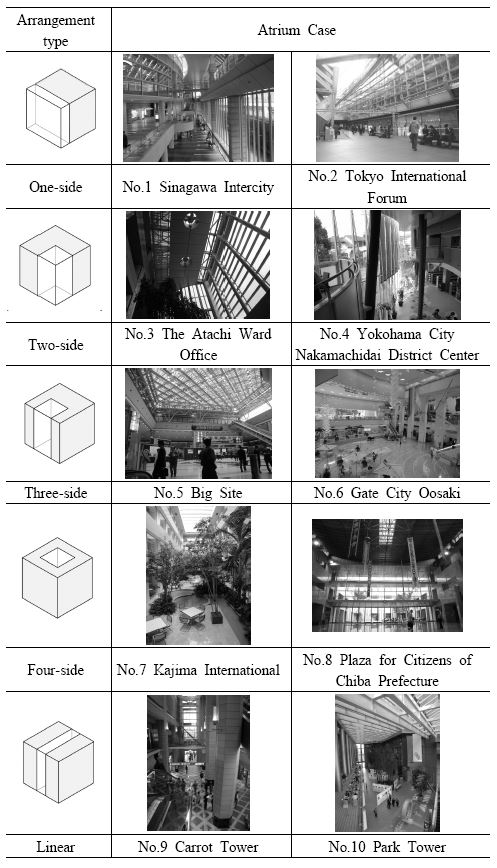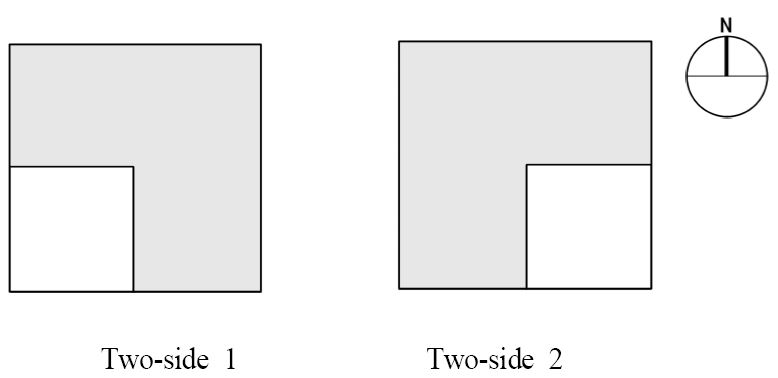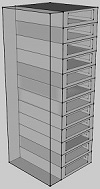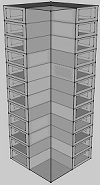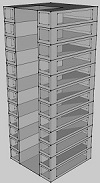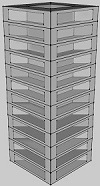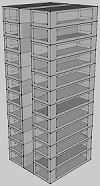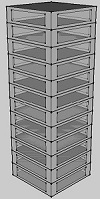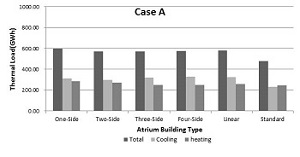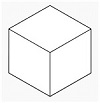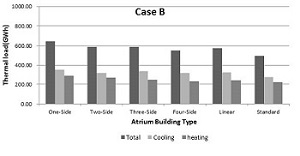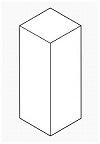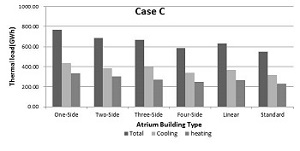
Heating and Cooling Load of Building according to Atrium Layout
© Copyright Korea Institute of Ecological Architecture and Environment
Abstract
The purpose of this study is to present basic data which would be applied on the early stage of the architectural design. And that determines the introduction of the atrium by comparing and analysing the environmental performance of atrium building.
The building forms are classified into low storied building, middle storied building and high storied building. This study compares and analyses energy performance of the standard building without atrium and the atrium building which has one-side, two-side, three-side, four-side, and linear atrium by measuring of annual heating and cooling load with EnergyPlus.
As a result of the analysis of the relative annual heating and cooling load by building type, it is shown that the fluctuation of cooling load in low storied building is large because heat storage in atrium affects building, and the fluctuation of heating load in high storied building is large owing to the effect of external wall area of atrium which makes heat loss. Especially, it indicated the largest annual heating and cooling load in four-side atrium of low storied building, and in one-side atrium of high storied building.
Keywords:
Atrium, EnergyPlus, Heating and Cooling Load키워드:
아트리움, 에너지플러스, 냉난방부하1. Introduction
1.1. Background and Purpose of Study
Modern construction such as large or public buildings often introduces atrium as a method to provide symbolism or comfort. Atrium is a large void space covered with glass and semi-external space in respect of construction planning and functions as buffer space between internal and external sections of a building or space for community and rest where channel of movement meets in internal section. It is environment friendly construction as it introduces natural lighting and ventilation to deep interior space to form comfort inner space. It is a huge space covered with glass, however, and has great cooling and heating load due to heat loss through glass or increased interior temperature by sunlight in summer, which poses disadvantage in energy savings. In particular, heat load of atrium has an effect on use space in a form where story-specific interior space is integrated with atrium space and consideration of energy saving is essential to atrium planning. Therefore, introduction of atrium is determined in the initial step of design, and if story-specific interior space and atrium is integrated, placement of atrium according to the type of building has great effect on the total energy load of a building and study for comparing environmental performance is required.
Most of previous studies about thermal environment of atrium construction are those for energy simulation of the thermal performance of atrium itself. Integrated study of psychological evaluation and environmental simulation to find appropriate satisfaction between openness of atrium construction and environmental performance1) performs energy simulation of atrium by using openings, orientation, proportion, etc. to investigate environmental load. Study for analyzing atrium type-specific energy performance uses temperature distribution analysis program and includes study on architectural element which has effect on temperature distribution and cooling and heating load within one-side type atrium2) and study for analysis on architectural element to block sunlight in summer temporarily by using simulation. Study for evaluating energy performance of atrium according to climatic conditions include study for analyzing energy performance by using EnergyPlus, a dynamic simulation to apply the same model to different climatic conditions3), study for analyzing energy performance according to the length or width of atrium in different climate zones by using DOE-2.1E building energy simulation program4) and study for comparing environmental performance of courtyard type atrium and building in different climate zones5).
As mentioned above, most of previous studies propose planning conditions of atrium for energy saving or architectural elements which have effect on cooling and heating load and evaluate energy performance of atrium itself in different climatic conditions based on energy simulation. In reality, however, atrium is connected with the use space of a building instead of separate installation and often integrated with it without wall in low storied building. In this case, it is difficult to predict thermal performance of the entire building according to the building type and placement of atrium in basic design step and reference is not sufficient to investigate this aspect.
Therefore, this study intends to compare energy performance according to types by considering the type and placement of the building and atrium in order to provide basic information for investigating thermal performance of the entire building where story-specific interior (use) space and atrium are integrated.
1.2. Method and Scope of Study
As for the energy performance of atrium, total annual cooling and heating load is analyzed by using EnergyPlus, a dynamic energy simulation program. Modeling is performed according to LOD 10 06) standard which is suitable for planning. As for the type of a building, total volume is made constant and the types are classified into low storied type which has wide and deep plane, high storied type which has narrow and shallow plane and the middle storied type. Atrium is set to have the same area and same height as the building for comparison according to building type and are classified into one-side, two-side, three-side, four-side and linear types and total energy performance of a building with (one-side to four-side, linear) and without atrium (standard type) has been compared.
2. Spatial and Environmental Characteristics According to Placement Type of Atrium
The placement types of atrium are classified into one-side, two-side, three-side and four-side according to the number of planes which have contact with the building and linear type where it is inserted between building to connect with external space. Fig. 1 shows the example of placement types of atrium. In Example No. 1 and 2 of one-side type, external space is established as landscaped void in the site, and atrium has strong visual and spatial connection with external space and plays a role as entrance to the building and buffer space between internal and external space. Example No. 7 of four-side type introduces natural lighting and ventilation to internal space of deep plane and is used as space for meeting and community activities of an office building. Example No. 8 places atrium and courtyard in parallel to overcome closed shape of atrium and takes similar spatial characteristics to one-side type. Example No. 9 of linear type is used as urban space such as sidewalk by providing a crossing shortcut. As above, architectural role and spatial characteristics of different atrium types have effect on the placement type. But, glass is made as the outer wall to reinforce connection with external space and obtain visual openness, resulting in increased air conditioning load due to heat loss environmentally. Also, ceiling which is installed to introduce natural lighting to internal space causes green house effect7) due to excessive sunlight in summer and stack effect8), resulting in heat storage in the top section and large energy load. Due to this problem, internal wall which has contact with atrium can be installed to set it thermal middle area without performing air conditioning for atrium. In a case where atrium is connected with internal space, however, the placement of atrium should be considered carefully to reduce energy load.
3. Simulation
3.1. Overview of EnergyPlus
EnergyPlus is a simulation program which only integrates the advantage of BLAST and DOE-2 and consists of three basic modules such as heat & mass balance simulation module, building system simulation module and simulation manage module which manages the entire simulation process). The simulation tool was developed by using ASHRAE 140 guideline of American Society of Heating Refrigerating and Air-conditioning Engineers and verified for three parts of building cooling & heating load, heating equipment and cooling equipment. The reliability of result values was confirmed by BESTEST(Building Energy Simulation TEST) of IEA (International Energy Agency). It is used as the simulation program to predict energy performance in the design of a new building in U.S.9)
3.2. Modeling of Atrium Construction
The volume (area×height) of the building and atrium was made identically to be 12000㎥(building) and 4000㎥(atrium) according to type. Area between atrium and use space is set to be integral design without wall and opening rate of use space is set to be 50%. Default values provided by EnergyPlus are used for wall thickness, insulation material and glass performance of atrium and use space. Total floor area of use space is set identically to be 3000㎡ and building area and height of use space are set differently to classify building types into low storied (case A), middle storied (case B) and high storied (case C) types. The low storied type has 1000㎡ of building area of use space and 12m of height in three stories. The middle storied type has 500㎡ of building area of use space and 24m of height in six stories. The high storied type has 250㎡ of building area of use space and 48m of height in twelve stories. The building area of atrium is set 333.33㎡, 166.66㎡ and 83.33㎡ for low-, middle- and high-storied types, respectively. The floor of buildings is set to be a square with the same width and length. The orientation is set to face south and for two-side atrium, types are classified into those face southeast and southwest (Fig. 2). According to previous study, the effect of orientation was 0.2%, similarly in the measurement of cooling and heating load for atrium facing southeast and southwest10). Therefore, this study uses two-side atrium facing southeast.
3.3. Modeling Levels
This study determined the modeling standard so that it can be used for planning & design step as reference for atrium planning by considering energy performance of building type. As there is no guideline on modeling in domestic design, LOD (Level of Development) of AIA (American Institute of Architects) has been referred to. Among LOD 100-500 stages (Table 2)11), LOD 100 stage is conceptual design level where mass shape, volume and building type are defined and building area, height, volume, position and orientation are determined. By considering the above mentioned, this study has modeled in accordance with LOD 100 stage.
3.4. Air Conditioning Data
SketchUp 2014 connected with EnergyPlus is used for modeling to investigate the energy performance of atrium and EnergyPlus 8.1.0.009 is used to enter and analyze data. Weather data provided by EnergyPlus for Incheon (latitude: 37.48, longitude: 126.55) among four Korean cities (Gangneung, Gwangju, Ulsan and Incheon) was entered to perform simulation. 8760 hours of operation time was used from Jan 1 to Dec 31 to measure annual cooling and heating load. ZoneMixing, a ZoneAirflow was set to mix 1.454 times per hour for smooth air exchange between atrium and building space.
As this study has to find cooling and heating load according to the type of building and atrium based on LOD 100 stage, default values provided by EnergyPlus are used for air conditioning data except weather data and operation time and those data for simulation are entered as shown in Table 3.
4. Analysis Results
Energy simulation was performed for buildings with and without atrium according to low- (case A), middle- (case B) and high-storied (case C) types in order to find energy performance of atrium placement types (one-side to four side, linear). Annual cooling load and heating load of each building were calculated for 365 days from Jan 1 to Dec 31 and cooling and heating loads of low-, middle- and high-storied standard building and placement type-specific atrium building were compared to find relative load of 18 building types. Relative load of atrium building types is calculated based on the load of the standard type and it is considered by analyzing separately the cover area and ceiling area of atrium, cover area of use space, relative value of contact area between atrium and use space and thermal load of atrium and use space in atrium.
4.1. Total Annual Cooling and Heating Load of Building
First, the building without atrium has shown the increase of total annual cooling and heating load as it moves from low-storied to high-storied. It results from the fact that the volume of buildings is the same but the area of outer wall with 50% of opening rate increases and total annual cooling and heating load has increased to 415.46GWh (low-storied, 1517㎡) 460.89GWh (middle-storied, 2146㎡) and 542.96GWh (high-storied, 3035㎡)(Table4,5).
It has been analyzed that the atrium building has relatively bigger total annual load than building without atrium in any placement type(Table4). As confirmed from the graph in Table 4, in low-storied type (case A), four-side type shows the biggest value, 1.559 times the standard type. In high-storied type (case C), one-side type shows the biggest value, 1.574 times as the standard type and relatively bigger difference in cooling and heating loads of atrium types than low-storied type. In particular, the building with four-side atrium shows the maximum cooling and heating load in low-storied type and one-side atrium building shows the maximum in high-storied type.
If we look at cooling and heating load, cooling load is greater than heating load and it is a characteristic load pattern in temperate climate zones such as Korea. As for the increase of cooling load in atrium building types, low- and high-storied types show 1.494~1.737 and 1.344~1.459 times the standard type, respectively, showing that low-storied type has bigger increase margin than high-storied type. In particular, four-side atrium building which was found to have the biggest total cooling and heating load (647.81GWh) in low-storied type has 1.737 and 1.349 times of cooling and heating loads, respectively if compared with the standard type, showing that it is more influenced by cooling load.
As for the increase of heating load in atrium building types, lowand high-storied types show 1.365~1.532 and 1.396~1.766 times the standard type, respectively, showing that high-storied type has bigger increase margin than low-storied type. In particular, one-side atrium building which was found to have the biggest total cooling and heating load (854.72GWh) in high-storied type has 1.766 and 1.459 times of heating and cooling loads, respectively if compared with the standard type, showing that it is more influenced by heating load.
4.2. Annual Cooling and Heating Load of Atrium and Use Space
This section analyzes the thermal loads of atrium and use space separately in order to find factors which has effect on cooling and heating load of a building with atrium(Table 6).
As for the increase margin of cooling and heating load in atrium building types, low-storied type shows that cooling load increases more and even the four-side atrium building with the biggest cooling and heating load among low-storied atrium buildings shows the biggest increase margin of cooling load. If we analyze use space and atrium separately, cooling load of low-storied, four-side type is more influenced by use space. As for the cooling load of use space, four-side type has the biggest (280.804GWh) and one-side type has the smallest (192.163GWh) values. As for the cooling load of atrium, one-side type has the biggest (151.415GWh) and four-side type has the smallest (110.449GWh) values. If we calculate this as relative value for total cooling and heating load of the standard type, atriums have small difference in cooling load of 0.490 (four-side)~0.672 (one-side) but use spaces have large increase margin of cooling load of 0.853 (one-side)~1.247 (four-side). Therefore, it is analyzed that the cooling load of use space has greater effect on the increase margin of cooling load than that of atrium in low-storied type. It is because in low-storied type with 12m of building height, the most of use space belongs to vertical distribution zone where heat storage occurs and low-storied type atrium building is more influenced by high temperature event due to heat storage than middle- and high-storied buildings. In particular, as for the four-side atrium building, it is because it has the biggest contact area (876㎡) between atrium and use space among five placement types. It is judged that the building has the biggest increase margin of cooling load as it also has the biggest cover area of use space (1752㎡).
As for the increase margin of cooling and heating load in atrium building types, high-storied type shows that heating load increases more and even the one-side atrium building with the biggest cooling and heating load among high-storied atrium buildings shows the biggest increase margin of heating load. If we analyze use space and atrium separately, heating load of high-storied, one-side type is more influenced by atrium. As for the heating load of atrium, one-side type has the biggest (163GWh) and four-side type has the smallest (43.043GWh) values. As for the heating load of use space, four-side type has the biggest (240.551GWh) and one-side type has the smallest (195.044GWh) values. If we calculate this as relative value for total cooling and heating load of the standard type, use spaces have small difference in heating load of 0.960 (one-side)~1.184 (four-side) but atriums have large increase margin of heating load of 0.212 (four-side)~0.804 (one-side). Therefore, it is analyzed that the heating load of atrium has greater effect on the increase margin of heating load than that of use space in high-storied type. It is related with the glass area of atrium and differences between the maximum and minium values of glass area (outer wall area+ceiling area) are 2.9 (one-side is 2.9 times four-side), 6.5 (one-side is 6.5 times four-type) and 16.8 (one-side is 16.8 times four-side) in low-, middle- and high-storied types, respectively. It is judged that the variation of heat loss is the biggest in high-storied type as it has the biggest difference in the atrium glass area. In particular, it is judged that one-side atrium building has the biggest increase margin of heating load as it has the largest glass area (1398㎡).
5. Conclusion
This study has analyzed thermal performance of building where story-specific interior space is integrated with atrium to provide basic data applicable to the initial design stage where introduction of atrium is determined by comparing environmental performance of atrium buildings. The method is based on LOD 100 stage and the volume of the building and atrium has been set identically for each type in order to compare energy performance. The building types were classified into low-, middle- and high-storied types and total annual cooling and heating loads of the buildings with (one-side to four-side, linear) and without atrium (standard type) were measured by using EnergyPlus. Results from comparison of cooling and heating load distribution among atrium buildings are as follows.
First, four-side atrium building has the biggest total annual cooling and heating load in low-storied type and it is analyzed that cooling and heating load of the entire building is more influenced by cooling load as the cooling load of use space has relatively large variation in the low-storied building. It has been found that in low-storied type where most of use space belongs to vertical distribution zone where heat storage occurs, cooling load increases as the area of use space which has contact with atrium and variation of cooling load is also large. In particular, four-side type had the biggest contact area between atrium and use space and outer wall area of use space and was analyzed to be the atrium placement type with the biggest cooling load and total annual cooling and heating load in low-storied type.
Second, one-side atrium building has the biggest total annual cooling and heating load in high-storied type and it is analyzed that cooling and heating load of the entire building is more influenced by heating load as the heating load of atrium has relatively large variation in the high-storied building. As for atriums where heat loss occurs in winter, the high-storied type has the largest difference in glass area among atrium placement types. In particular, it is judged that one-side type is the atrium placement type with the biggest heating load and total annual cooling and heating load as it has the biggest glass area among high-storied types, resulting in large heat loss through atrium.
Any type of atrium building has been analyzed to disadvantageous to energy efficiency as it has larger total annual cooling and heating load than the building without atrium. To overcome this problem, however, improvement of thermal performance of glass or introduction of local heating or natural ventilation centered on occupied zone is being tried. As for common south-facing buildings, one-side atrium is most disadvantageous to energy efficiency if we look at atrium alone. As for the cooling and heating load of the entire building when atrium and use space are integrated, four-side and one-side atrium buildings have the biggest cooling and heating load in low- and high-storied types, respectively if we make the volume of atrium and use space identical and perform comparison according to proportions and atrium placement types. This study classified atrium buildings according to low-, middle- and high-storied types and atrium placement types and then compared the cooling and heating load of the entire building instead of atrium load only to provide a reference for design of atrium construction. Comprehensive study is required further to consider more various cases.
Acknowledgments
This research was supported by Basic Science Research Program through the National Research Foundation of Korea(NRF) funded by the Ministry of Education (2015R1D1A3A01016292) , This research was partially supported by the Cheongju University Research Scholarship Grants in 2014-2015.
Notes
References
-
신철우, “부착형 아트리움의 실내 온도분포 및 냉난방 부하에 영향을 미치는 건축적 요소에 관한 연구”, 수원대학교, 석사학위논문, (1998).
Sin, Chul-Woo, “A Study on the Design Parameters Having an Influence on Indoor Air Temperature Distribution and Cooling-Heating Loads of an Attached Atrium“, Suwon University, Master's Thesis, (1998). -
이지영, 이경선, “아트리움 공간의 친환경적 활용 사례연구”, 대한건축학회논문집 계획계, 26(9), (2010).
Lee, Ji-Young, Lee, Kyung-Sun, “Study on Examples of Sustainable Environment Application in Atrium Space”, Review of architecture and building science, 26(9), (2010). -
이지영, 손장열, 이영균, “친환경적 아트리움을 위한 개구부계획”, 대한건축학회논문집 계획계, 26(1), (2010).
Lee, Ji-Young, Sohn, Jang-Yeul, Lee, Young-Gyun, “Planning Conditions of Opening for Environment-friendly Atrium”, Review of architecture and building science, 26(1), (2010). -
추승연, 이권형, 박선경, “Green BIM 가이드라인 개발을 위한 모델링 수준(Level of Development) 설정에 관한 연구, 에너지 성능평가를 중심으로”, 대한건축학회 논문집 계획계, 28(6), (2012).
Choo, Seung-Yeo, Lee, Kweon-Hyoun, Park, Sun-Kyoung, “A Study on LOD(Level of Development) for Development of Green BIM Guidelines, Focused on Energy Performance Estimation”, Review of architecture and building science, 47(10), (2012). -
정승우, 이권형, 김인한, 추승연, “Green BIM기반 초기설계 단계에서 타입별 아트리움의 규모산정에 관한 연구”, CAM학회 논문집, 18(1), (2013).
Jeong, Seung-Woo, Lee, Kweon-Hyoung, Kim, In-Han, Choo, Seung-Yeon, “Analysis on Green BIM based Atrium Sizes in the Early Design Stage”, Transactions of the Society of CAD/CAM Engineers, 18(1), (2013). -
윤여범, 이광호, “연간 건물에너지 시뮬레이션 소프트웨어-EnergyPlus”, 설비저널, 43(9), (2014).
Yoon, Yeo-Beom, Lee, Kwang Ho, “Annual Building Energy Simulation Software—EnergyPlus”, The magazine of the Society of Air-conditioning and Refrigerating Engineers of Korea, 43(9), (2014). -
최정민, “1면 부착형 아트리움의 하계 열환경 특성 사례 연구”, 한국건축친환경설비학회 논문집, 8(5), (2014).
Choi, Jeong-Min, “A Case Study on the Characteristics of Summer Thermal Environment of Single-side attached Atrium”, Journal of Korean Institute of Architectural Sustainable Environment and Building Systems, 8(5), (2014). -
Abdelsalam Aldawoud, Ray Clark, “Comparative analysis of energy performance between courtyard and atrium in buildings”, Energy and Buildings, 40(3), (2008).
[https://doi.org/10.1016/j.enbuild.2007.02.017 ]

- Yiaun Pan, Yuming Li, Zhizhong Huang, Study on Energy Modeling Methods of Atrium Buildings, International IBPSA Building Simulation Conference, Building Simulation 2009, (2009).
-
Abdelsalam Aldawoud, “The influence of the atrium geometry on the building energy performance”, Energy and Buildings, 57, (2013, February).
[https://doi.org/10.1016/j.enbuild.2012.10.038]

- Ahmed Qadir Ahmed, Energy Performance of Courtyard and Atrium in Different Climates, Renewable Energy and Architecture, p1-14, (2013).
- Diego Palma Rojas, “Atrium building design: key aspects to improve their thermal performance on the Mediterranean climate of Santiago de Chile”, International journal of low carbon technologies, 9(4), (2014).
- E. Djunaedy, J.L.M. Hensen, M.G.L.C. Loomans, “External Coupling between CFD and Energy Simulation: Implementation and Validation”, Renewable Energy, 63, (2014).
